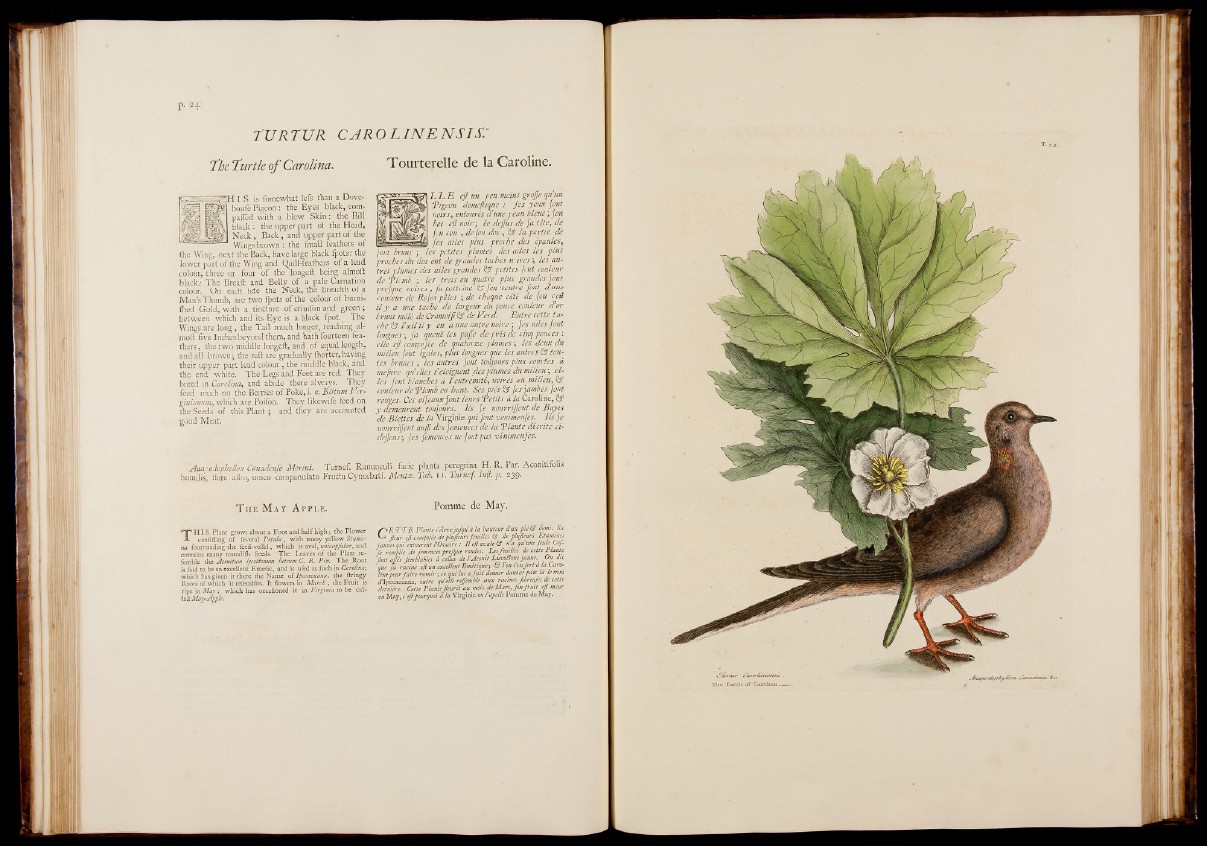
p. 24
The furile of Carolina. Tourterelle de la Caroline.
¡H I S is fomewhat lefs than a Dove-
houfe Pigeon : the Eyes black, com-
palled with a blew Skin : the Bill
black : the upper part of the Head,
Neck, Back, and upper part of the
Wings brown : the fmall feathers of
the Wing, next the Back, have large black ipots: the
lower part of the Wing and Quill-feathers of a lead
colour, three or four of the longeft being almoft
black: The Breaft and Belly of a pale Carnation
colour. On each fide the Neck, the breadth of a
Man’s Thumb, are two fpots of the colour of burni-
fhed Gold, with a tin&ure*. of crimfon and green
between which and its Eye is a black ipot. The
Wings are long, the Tail much longer, reaching ab
moft five Inches beyond them, and hath fourteen feathers,
the two middle longeft, and of equal length,
and all brown; the reft are gradually fhorter,having
their upper part lead colour, the middle black, and
the end white. The Legs and Feet are red. They
breed in Carolina:, and abide there always. They
feed much on the Berries of Poke,i. e.Blitum V ir-
gznictnum, which are Poifon. They likewiie feed on
the Seeds of this Plant ; and they are accounted
good Meat.
j L h E ejl un peu moins groffe qu'un
1 Pigeon domeflique : je s yeux font
noirs, entourés a une peau i l eue ; Jon
I bec efl noir j le deffus de fa tête, de
fcn cou , de fon dos, ëf la partie de
f/> f ailes plus proche des épaules,
¡ont bruns ; les. petites plumes des ailes les plus
proches du dos ont de grandes taches mires ; les autres
plumes des ailes grandes & petites fcnt couleur
de Plcmb ; les trois ou quatre plus grandes font
prefque noires ; fa poitrine fon ventre font a une
couleur de Rofes pâles ; de chaque coté de fon cote
il.y a une tache, de largeur du pouce couleur d’or
bruni mêlé de Cramoifi & de Ver d: Entre cette tache
& l ’oeil il y en a une autre noire ; fes ailes font
longues ; fa queuè les paffe de prés de cinq pouces :
elle efl compofée de quatorze plumes ; les deux du
milieu font égales, plus longues que les autres ¡¡J toutes
b rim e s le s autres font toujours plus courtes à
me fur e qu’elles s’éloignent 'des plumes du milieu ; elles
font blanches a l’extrémité, noires au milieu, &
couleur de Plomb en haut. Ses piés & fes jambes font
rouges. Ces oifeaux font leurs 'Petits à la Caroline,
y demeurent toujours. Ils fe nourriffent de Bayes
de Blettes de la Virginie qui font venimeufes. Ils fe
nourriffent auffi des femences de la Plante décrite ci-
deffous; fes femences ne font pas vénimeufes.
Aoaioâofhyüon Canadese Marini. Turnei;. Ranunculi farie pianta peregrina H. R. Par. Aconltifolia
humilis, fiore albo, unico-campanulato FruÉtu Cynosbati. Mcntz. Tab. i l . Tumef. Jn fi.p . 239.
T h e M a y A p p l e .
TH I S Plant grows about a Foot and half high; the Flower
confifting of feveral Pétala, with many yellow Stamina
fourrunding the feed-veffel, which is oval, unicapfular,and
contains many roundilh Seeds. The Leaves o f the Plant re-,
femble the Aconitum lycoElonum luteum C. B . Pin. The Root
is faid to be an excellent Emetic, and is ufed as fuch in Carolina;
which has given it there the Name o f Ipecacuana, the ftringy
Roots of which it refembles. It flowers in March , the Fruit is
ripe in May ; which has occafioned it in Virginia to be called
May-Apple.
Pomme de May.
CE Ï Ï E Plante s’èlevejufqu’a la hauteur d’un pié& demi. Sa
fleur efl compofée de plufleurs feuilles & de plufleurs Etamines
jaunes qui entourent l’Ovaire : I l efi ovale & n’a qu’une feule Cof-
fe remplie de femences prefque rondes. Les feuilles de cette Plante
font ajfés femblables à celles de PAconit Luvottone jaune. On dit
que fa racine efl un excellent Emitique ; & P on s’en Jert a la Caroline
pour faire vomir; ce qui lui a fa it donner dans ce pais là le nom
¿flpecàcuana, outre qu’elle reffemble aux racines fibreufes de cette
dernière. Cette Plante fleurit au mois de Mars, fon fru it efl meur
en May, c’efl pourquoi à la Virginie on P apelle Pomme de May.